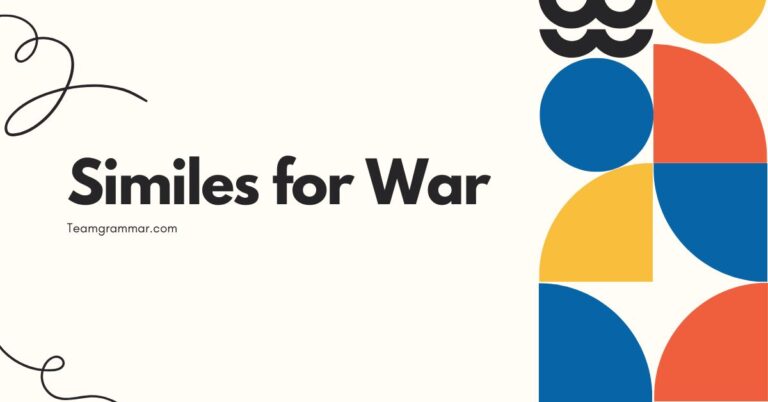31 Similes for Big: Mastering Figurative Language
Similes are powerful tools in the English language, allowing us to create vivid comparisons and enhance our writing and speech. Understanding and using similes effectively can significantly improve your communication skills.
This article provides a comprehensive guide to similes for “big,” exploring their structure, variations, and usage. Whether you’re a student, writer, or language enthusiast, this guide will equip you with the knowledge and practice to master similes and add depth to your expressions.
Table of Contents
- Introduction
- Definition of Similes
- Structural Breakdown of Similes
- Types of Similes
- Examples of Similes for “Big”
- Usage Rules for Similes
- Common Mistakes with Similes
- Practice Exercises
- Advanced Topics in Similes
- Frequently Asked Questions
- Conclusion
Introduction
Similes are essential components of figurative language, enriching our ability to describe and compare things in imaginative ways. They help us paint vivid pictures with words, making our communication more engaging and memorable.
Specifically, similes that describe something as “big” can convey not only physical dimensions but also abstract concepts like importance, impact, or scale. Mastering these similes allows for more nuanced and effective expression, enhancing both writing and conversational skills.
This article is designed to provide a thorough understanding of similes that relate to the concept of “big.” We will explore the definition of similes, their structural elements, different types, and numerous examples. We’ll also cover usage rules, common mistakes to avoid, and practice exercises to solidify your understanding.
Whether you are a student looking to improve your writing, a professional seeking to enhance your communication skills, or simply a language enthusiast, this guide will provide valuable insights and practical tools for mastering similes for “big.” Dive in and discover the power of figurative language to elevate your expression!
Definition of Similes
A simile is a figure of speech that directly compares two different things using the words “like” or “as.” The purpose of a simile is to create a vivid image or convey a specific quality by associating the subject with something more familiar or evocative. Similes are a type of metaphor, but unlike metaphors, they explicitly state the comparison using “like” or “as.”
Classification:Similes fall under the broader category of figurative language and are closely related to metaphors. Figurative language uses words or expressions with a meaning that is different from the literal interpretation.
Similes are a specific type of comparison that highlights similarities between two distinct entities.
Function:The primary function of a simile is to enhance description and create a more engaging and memorable experience for the reader or listener. By drawing a comparison, similes can clarify complex ideas, evoke emotions, and add depth to writing and speech.
They allow for a more creative and imaginative expression compared to literal descriptions.
Contexts:Similes are used across various contexts, including literature, poetry, everyday conversation, advertising, and persuasive writing. They are particularly common in creative writing to add imagery and depth.
In everyday conversation, similes can help to make explanations clearer and more relatable. In advertising, they can be used to highlight the benefits of a product by comparing it to something desirable.
Structural Breakdown of Similes
A simile typically consists of three main components:
- The Subject: This is the thing being described or compared.
- The Comparison Word: This is either “like” or “as,” which explicitly indicates that a comparison is being made.
- The Object of Comparison: This is the thing to which the subject is being compared. It provides a point of reference to highlight a specific quality or characteristic of the subject.
Pattern: The basic pattern of a simile is as follows:
Subject + Comparison Word (like/as) + Object of Comparison
For example:
The building (subject) + is as (comparison word) + big as an elephant (object of comparison).
Variations: While the basic structure remains consistent, similes can be varied to create different effects. For example, the order of elements can be altered, or additional descriptive words can be added to the subject or object of comparison.
Example of a simple simile: “He is as strong as an ox.”
Example of a simile with added description: “The old oak tree is as big and imposing as a medieval castle.”
Understanding the structural elements of a simile allows for more effective creation and interpretation of these figures of speech. By recognizing the subject, comparison word, and object of comparison, you can better appreciate the intended meaning and impact of the simile.
Types of Similes
Similes can be categorized based on the type of comparison they make or the characteristic they emphasize. Here are some common types of similes used to describe “big”:
- Similes for Physical Size: These similes compare the subject to something that is physically large, such as “as big as a house” or “like a giant.”
- Similes for Scope or Extent: These similes emphasize the broadness or comprehensiveness of something, such as “as wide as the ocean” or “like a never-ending story.”
- Similes for Impact or Significance: These similes highlight the importance or influence of something, such as “as significant as a historical event” or “like a turning point.”
- Similes for Abstract Bigness: These similes describe abstract qualities like ambition or dreams, such as “as big as the sky” or “like a boundless imagination.”
- Similes for Large Quantities: These similes describe the abundance or numerousness of something, such as “as many as the stars in the sky” or “like a swarm of bees.”
Each type of simile serves a different purpose and can be used to create a specific effect. Understanding these categories can help you choose the most appropriate simile for your intended meaning.
Examples of Similes for “Big”
This section provides a variety of examples of similes that describe something as “big,” organized by category. Each category includes multiple examples to illustrate the range of possibilities and nuances within each type.
Similes for Physical Size
These similes are used to compare the physical dimensions of something to something else that is known to be large. They help to create a visual image of the size of the subject.
The following table provides examples of similes that describe physical size:
| Simile | Explanation |
|---|---|
| As big as a house | Describes something that is very large in terms of its physical dimensions, comparable to the size of a house. |
| Like a giant | Indicates that something is enormous and imposing, similar to a mythical giant. |
| As large as a whale | Compares the size of something to that of a whale, emphasizing its immense proportions. |
| As huge as a mountain | Suggests that something is massive and towering, like a mountain. |
| Like a skyscraper | Indicates that something is very tall and large, similar to a skyscraper. |
| As broad as a barn | Describes something that is wide and expansive, like the width of a barn. |
| Like a colossal statue | Implies that something is impressively large and imposing, similar to a massive statue. |
| As immense as an ocean liner | Compares the size of something to that of a large ship, emphasizing its vastness. |
| Like a sprawling city | Indicates that something covers a large area, similar to a city that stretches out in all directions. |
| As bulky as a refrigerator | Describes something that is large and takes up a lot of space, like a refrigerator. |
| Like a massive oak tree | Suggests something that is tall and broad, similar to a mature oak tree. |
| As big as a bus | Describes something with the size of a public transport vehicle. |
| Like a large aircraft carrier | Implies the size is similar to a warship designed to carry aircraft. |
| As tall as an office building | Indicates a height comparable to a multi-story office structure. |
| Like a hefty sumo wrestler | Describes someone or something as being very large and robust. |
| As wide as a football field | Compares the width to the expansive area of a sports field. |
| Like a giant sequoia tree | Suggests a size similar to one of the largest trees on Earth. |
| As enormous as a blue whale | Compares the size to the largest animal on the planet. |
| Like a vast warehouse | Indicates a space as large as a storage facility. |
| As high as the Empire State Building | Compares height to a famous tall building. |
| Like a huge cargo train | Describes something as long and massive as a train car. |
| As big as a small car | Indicates that the object is similar in size to a compact vehicle. |
| Like an enormous billboard | Describes something as strikingly large and visible, similar to a giant advertisement. |
| As high as a Ferris wheel | Compares the height to a large, rotating amusement ride. |
| Like a large shipping container | Indicates a size similar to the standard containers used for transporting goods. |
Similes for Scope or Extent
These similes are used to describe the range, reach, or comprehensiveness of something. They help to convey the extent or breadth of the subject.
The following table provides examples of similes that describe scope or extent:
| Simile | Explanation |
|---|---|
| As wide as the ocean | Describes something that is very broad or extensive, like the expanse of the ocean. |
| Like a never-ending story | Indicates that something seems to go on indefinitely or without end. |
| As far as the eye can see | Suggests that something stretches out over a great distance, limited only by the viewer’s sight. |
| Like a boundless plain | Implies that something has no limits or boundaries, similar to a vast, open plain. |
| As comprehensive as an encyclopedia | Describes something that is very thorough and covers a wide range of topics, like an encyclopedia. |
| Like a global network | Indicates that something is interconnected and reaches across the world. |
| As extensive as a library | Suggests that something is vast and contains a great deal of information, like a library. |
| Like a sprawling empire | Implies that something covers a large territory and has a significant influence, similar to an empire. |
| As inclusive as the universe | Describes something that encompasses everything, without exclusion. |
| Like a limitless horizon | Indicates that something has no apparent boundaries or restrictions. |
| As broad as a continent | Describes something with the expanse and diversity of a large landmass. |
| Like an endless maze | Suggests something complicated and without a clear end. |
| As vast as outer space | Compares the scale to the virtually limitless universe. |
| Like a worldwide phenomenon | Indicates something affecting many people or places globally. |
| As wide-ranging as a scientific study | Describes something covering many aspects or areas. |
| Like an all-encompassing umbrella | Suggests a protective or inclusive coverage. |
| As limitless as human potential | Compares the scope to the boundless possibilities of people. |
| Like a complete collection | Indicates something that includes all possible items or aspects. |
| As expansive as a company’s portfolio | Describes something with a diverse and extensive range of assets. |
| Like a comprehensive database | Suggests a large and thorough collection of information. |
| As stretched as the Earth’s timeline | Describes something with an incredibly long duration. |
| Like an all-inclusive resort | Indicates a service covering everything one could want. |
| As boundless as the imagination | Compares the scope to the unlimited nature of creativity. |
| Like a full spectrum | Describes something that includes all possible variations. |
| As limitless as the sky | Suggests something uninterrupted and far-reaching. |
Similes for Impact or Significance
These similes are used to describe the importance, influence, or effect of something. They help to convey the magnitude of the subject’s impact.
The following table provides examples of similes that describe impact or significance:
| Simile | Explanation |
|---|---|
| As significant as a historical event | Describes something that has a major impact and lasting importance, like a historical event. |
| Like a turning point | Indicates that something marks a critical moment or change in direction. |
| As influential as a world leader | Suggests that something has a great deal of power to affect others, like a world leader. |
| Like a game-changer | Implies that something fundamentally alters the way things are done. |
| As impactful as a natural disaster | Describes something that has a powerful and often devastating effect. |
| Like a pivotal moment | Indicates that something is crucial and decisive. |
| As important as a life-saving measure | Suggests that something is essential and can prevent serious harm. |
| Like a landmark decision | Implies that something sets a precedent and has far-reaching consequences. |
| As crucial as a keystone | Describes something that is essential for the stability and integrity of the whole. |
| Like a watershed moment | Indicates that something marks a significant turning point in history or development. |
| As profound as a philosophical insight | Describes something with deep meaning and understanding. |
| Like a revolutionary invention | Suggests something that fundamentally changes society or industry. |
| As consequential as a legal precedent | Compares the impact to a decision that guides future judgements. |
| Like a major breakthrough | Indicates significant progress or discovery. |
| As pivotal as a national election | Describes something with the potential to change the course of a country. |
| Like a cultural phenomenon | Suggests widespread influence on society’s customs and trends. |
| As transformative as a spiritual awakening | Compares the impact to a profound change in perspective. |
| Like a monumental achievement | Indicates a great and lasting accomplishment. |
| As vital as oxygen | Describes something absolutely necessary for survival. |
| Like a critical component | Suggests something essential to the function of a system. |
| As resonant as a symphony | Describes something powerful and moving. |
| Like a seismic shift | Indicates a sudden and significant change. |
| As compelling as a magnet | Describes something irresistibly attractive or influential. |
| Like a beacon of hope | Suggests something that provides guidance and encouragement. |
| As formative as childhood experiences | Compares the impact to early life events that shape an individual. |
Similes for Abstract Bigness
These similes are used to describe abstract qualities or concepts that are large in scope or intensity. They help to convey the magnitude of something that is not physically measurable.
The following table provides examples of similes that describe abstract bigness:
| Simile | Explanation |
|---|---|
| As big as the sky | Describes something that is vast and limitless, like the sky. |
| Like a boundless imagination | Indicates that something has no limits or constraints, similar to a limitless imagination. |
| As deep as the ocean | Suggests that something is profound and immeasurable, like the depth of the ocean. |
| Like an endless dream | Implies that something seems to go on indefinitely and is filled with possibilities. |
| As vast as the universe | Describes something that is immense and incomprehensible, like the universe. |
| Like a bottomless pit | Indicates that something is insatiable or without end. |
| As strong as an unshakeable belief | Suggests that something is firm and unwavering, like a strong belief. |
| Like a burning passion | Implies that something is intense and consuming, similar to a burning passion. |
| As wide as empathy | Describes something inclusive and understanding of others’ feelings. |
| Like a limitless potential | Indicates that something has endless possibilities. |
| As complex as human nature | Describes something intricate and multifaceted. |
| Like a profound mystery | Suggests something deep and difficult to understand. |
| As rich as a tapestry | Compares the depth to a detailed and colorful artwork. |
| Like an expansive mind | Indicates a great capacity for thought and understanding. |
| As all-encompassing as love | Describes something that embraces everything. |
| Like an infinite loop | Suggests something that never ends. |
| As powerful as a force of nature | Compares the strength to natural phenomena. |
| Like an unyielding spirit | Indicates a determination that cannot be broken. |
| As vast as knowledge | Describes something with a large amount of information. |
| Like an endless quest | Suggests a journey without a clear end. |
| As immense as grief | Compares the emotional weight to a heavy burden. |
| Like a sea of tranquility | Indicates a state of profound peace. |
| As towering as ambition | Describes a high level of aspiration. |
| Like a universe of thoughts | Suggests a complex and expansive inner world. |
| As deep as a well of sorrow | Compares the intensity of sadness to a deep source. |
Similes for Large Quantities
These similes are used to describe a large number or amount of something. They help to convey the abundance or numerousness of the subject.
The following table provides examples of similes that describe large quantities:
| Simile | Explanation |
|---|---|
| As many as the stars in the sky | Describes a quantity that is countless and vast, like the number of stars in the sky. |
| Like a swarm of bees | Indicates a large and active group of things or people. |
| As numerous as grains of sand | Suggests a quantity that is virtually impossible to count, like grains of sand. |
| Like a sea of faces | Implies a large crowd of people. |
| As abundant as leaves on a tree | Describes a quantity that is plentiful and readily available. |
| Like a mountain of paperwork | Indicates a large and overwhelming amount of documents. |
| As countless as the waves on the shore | Suggests a quantity that is endless and constantly changing. |
| Like an army of ants | Implies a large and organized group of things or people. |
| As plentiful as raindrops in a storm | Describes a quantity that is abundant and widespread. |
| Like a cascade of emotions | Indicates a large and overwhelming outpouring of feelings. |
| As many as the blades of grass in a field | Describes a quantity that is too numerous to count. |
| Like a flood of memories | Suggests a large and overwhelming number of recollections. |
| As abundant as fish in the sea | Compares the quantity to the large population of marine life. |
| Like a multitude of choices | Indicates a wide array of options. |
| As countless as the cells in the body | Describes a quantity that is beyond human comprehension. |
| Like a plethora of opportunities | Suggests a large and diverse set of chances. |
| As numerous as the thoughts in a day | Compares the quantity to the constant stream of mental activity. |
| Like a torrent of words | Indicates a rapid and overwhelming flow of speech. |
| As many as the stars in the galaxy | Describes a quantity that is astronomically high. |
| Like an ocean of data | Suggests a vast and complex collection of information. |
| As profuse as blossoms in spring | Describes something that is abundant and flourishing. |
| Like a deluge of emails | Indicates an overwhelming number of electronic messages. |
| As bountiful as a harvest | Compares the quantity to a rich and plentiful yield. |
| Like a sea of supporters | Suggests a large crowd of people in favor of something. |
| As frequent as heartbeats | Describes something that occurs very often. |
Usage Rules for Similes
Using similes effectively involves adhering to certain rules to ensure clarity and impact. Here are some key usage rules to keep in mind:
- Ensure a Clear Comparison: The two things being compared should have a clear and recognizable similarity. The comparison should enhance the understanding of the subject by relating it to something familiar.
- Use “Like” or “As”: Similes must use either “like” or “as” to explicitly indicate the comparison. This distinguishes them from metaphors, which imply a comparison without using these words.
- Avoid Clichés: While some similes are common, try to avoid overused or clichéd similes that have lost their impact. Strive for originality and creativity in your comparisons.
- Maintain Consistency: Ensure that the comparison is logical and consistent with the context. The simile should fit the tone and style of the writing or speech.
- Consider the Audience: Choose similes that will be easily understood and appreciated by your audience. Consider their background, knowledge, and cultural context.
Exceptions: While these rules generally apply, there can be exceptions in creative writing where unconventional or surprising similes are used for artistic effect. However, these should be used sparingly and with careful consideration of their impact.
Example of a good simile: “The project was as big as a mountain to climb, but we tackled it together.”
Example of a cliché simile: “As big as an elephant” (This is overused and lacks originality.)
By following these usage rules, you can create similes that are both effective and engaging, enhancing your communication and adding depth to your expression.
Common Mistakes with Similes
Even with a good understanding of similes, it’s easy to make common mistakes. Recognizing these errors can help you avoid them and use similes more effectively.
- Using Metaphors Instead of Similes: Confusing similes with metaphors is a common mistake. Remember that similes use “like” or “as,” while metaphors imply a comparison without these words.
- Creating Illogical Comparisons: The comparison should be clear and logical. Avoid comparing things that have no apparent similarity.
- Using Clichéd Similes: Overusing common similes can make your writing or speech sound unoriginal and uninspired.
- Being Too Vague: The comparison should be specific enough to create a clear image or convey a specific quality. Avoid vague or general similes that lack impact.
- Inconsistency: Ensure that the simile is consistent with the tone and style of the writing or speech.
The following table provides examples of common mistakes and their corrections:
| Incorrect | Correct | Explanation |
|---|---|---|
| The problem was a mountain. | The problem was like a mountain. | The first sentence is a metaphor, while the second is a simile using “like.” |
| The building was as big as a grape. | The building was as big as a skyscraper. | The first comparison is illogical, while the second is clear and logical. |
| The project was as big as it could be. | The project was as big as a new stadium. | The first simile is vague, while the second provides a specific point of reference. |
| He was big like a whale. | He was as big as a whale. | The correct simile uses “as” instead of “like” in this construction. |
| Her ambition was like a big. | Her ambition was as big as the sky. | The first simile is incomplete, while the second provides a clear comparison. |
By being aware of these common mistakes and practicing using similes correctly, you can improve your ability to create effective and engaging comparisons.
Practice Exercises
To solidify your understanding of similes for “big,” try these practice exercises. Each exercise includes multiple questions of varying difficulty.
Exercise 1: Fill in the Blanks
Complete the following sentences by filling in the blanks with appropriate similes using “like” or “as.”
| Question | Answer |
|---|---|
| 1. The problem seemed ______ to overcome. | 1. The problem seemed as big as a mountain to overcome. |
| 2. Her ambition was ______ the sky. | 2. Her ambition was as big as the sky. |
| 3. The crowd was ______ of faces. | 3. The crowd was like a sea of faces. |
| 4. The project was ______ a new stadium. | 4. The project was as big as a new stadium. |
| 5. The task ahead seemed ______ effort. | 5. The task ahead seemed like a herculean effort. |
| 6. His ego was ______ a hot air balloon. | 6. His ego was as big as a hot air balloon. |
| 7. The influence of the company was ______ a global network. | 7. The influence of the company was like a global network. |
| 8. The challenge was ______ a never-ending story. | 8. The challenge was like a never-ending story. |
| 9. My appetite today is ______ . | 9. My appetite today is as big as a bear’s. |
| 10. The amount of information was ______ . | 10. The amount of information was like an ocean. |
Exercise 2: Identify the Type of Simile
Identify the type of simile used in each of the following sentences (Physical Size, Scope or Extent, Impact or Significance, Abstract Bigness, Large Quantities).
| Question | Answer |
|---|---|
| 1. The building was as big as a house. | 1. Physical Size |
| 2. Her influence was like a turning point. | 2. Impact or Significance |
| 3. His ambition was as big as the sky. | 3. Abstract Bigness |
| 4. The crowd was like a sea of faces. | 4. Large Quantities |
| 5. The project was as wide as the ocean. | 5. Scope or Extent |
| 6. The problem was as deep as the ocean. | 6. Abstract Bigness |
| 7. The number of stars was like an endless amount. | 7. Large Quantities |
| 8. The movie was as significant as a historical event. | 8. Impact or Significance |
| 9. The field was as vast as a continent. | 9. Scope or Extent |
| 10. The book was as bulky as a brick. | 10. Physical Size |
Exercise 3: Rewrite the Sentences Using Similes
Rewrite the following sentences using similes to describe the “big” aspect.
| Question | Answer |
|---|---|
| 1. The problem was very difficult. | 1. The problem was as big as a mountain to climb. |
| 2. Her ambition was limitless. | 2. Her ambition was as big as the sky. |
| 3. There were many people in the crowd. | 3. The crowd was like a sea of faces. |
| 4. The project was very extensive. | 4. The project was as wide as the ocean. |
| 5. The impact of the decision was significant. | 5. The impact of the decision was like a turning point. |
| 6. The amount of data was enormous. | 6. The amount of data was like an ocean. |
| 7. The challenge seemed impossible. | 7. The challenge seemed as big as trying to move the Earth. |
| 8. The news was very important. | 8. The news was as significant as a historical event unfolding. |
| 9. The room was very large. | 9. The room was as big as a ballroom. |
| 10. The task required a lot of effort. | 10. The task required an effort like moving a skyscraper. |
Advanced Topics in Similes
For those looking to deepen their understanding of similes, here are some advanced topics to explore:
- Extended Similes: These are similes that are developed over several sentences or even paragraphs, creating a more elaborate and detailed comparison.
- Subverted Similes: These are similes that intentionally break the expected pattern or create an unexpected comparison for humorous or ironic effect.
- Cultural and Contextual Similes: These are similes that rely on specific cultural or contextual knowledge to be fully understood and appreciated.
- Similes in Different Genres: Explore how similes are used differently in various genres, such as poetry, fiction, non-fiction, and advertising.
Example of an extended simile: “Her determination was like a river, starting as a small stream of resolve, gradually growing stronger as it flowed through challenges, gathering momentum and power until it became a mighty force capable of carving its way through mountains.”
Example of a subverted simile: “He was as sharp as a marble.” (This is unexpected and humorous because marbles are not sharp.)
By exploring these advanced topics, you can further refine your understanding and use of similes, adding even more depth and creativity to your expression.
Frequently Asked Questions
Conclusion
Mastering similes for “big” involves understanding their structure, types, and usage rules, as well as avoiding common mistakes. By exploring various examples and practicing with exercises, you can enhance your ability to create effective and engaging comparisons.
Whether you’re describing physical size, scope, impact, abstract qualities, or large quantities, similes can add depth and creativity to your writing and speech. Embrace the power of figurative language to elevate your expression and communicate more effectively.







